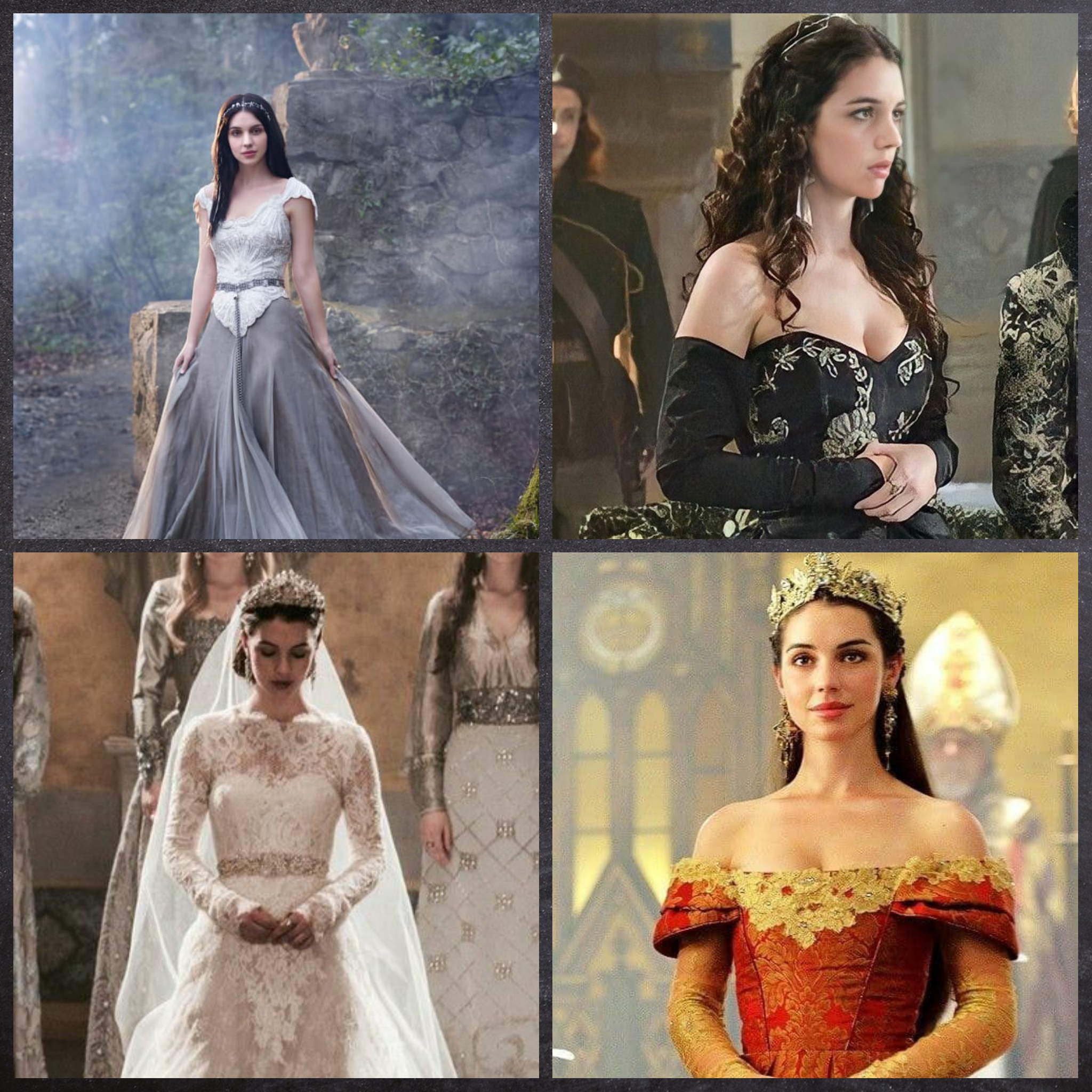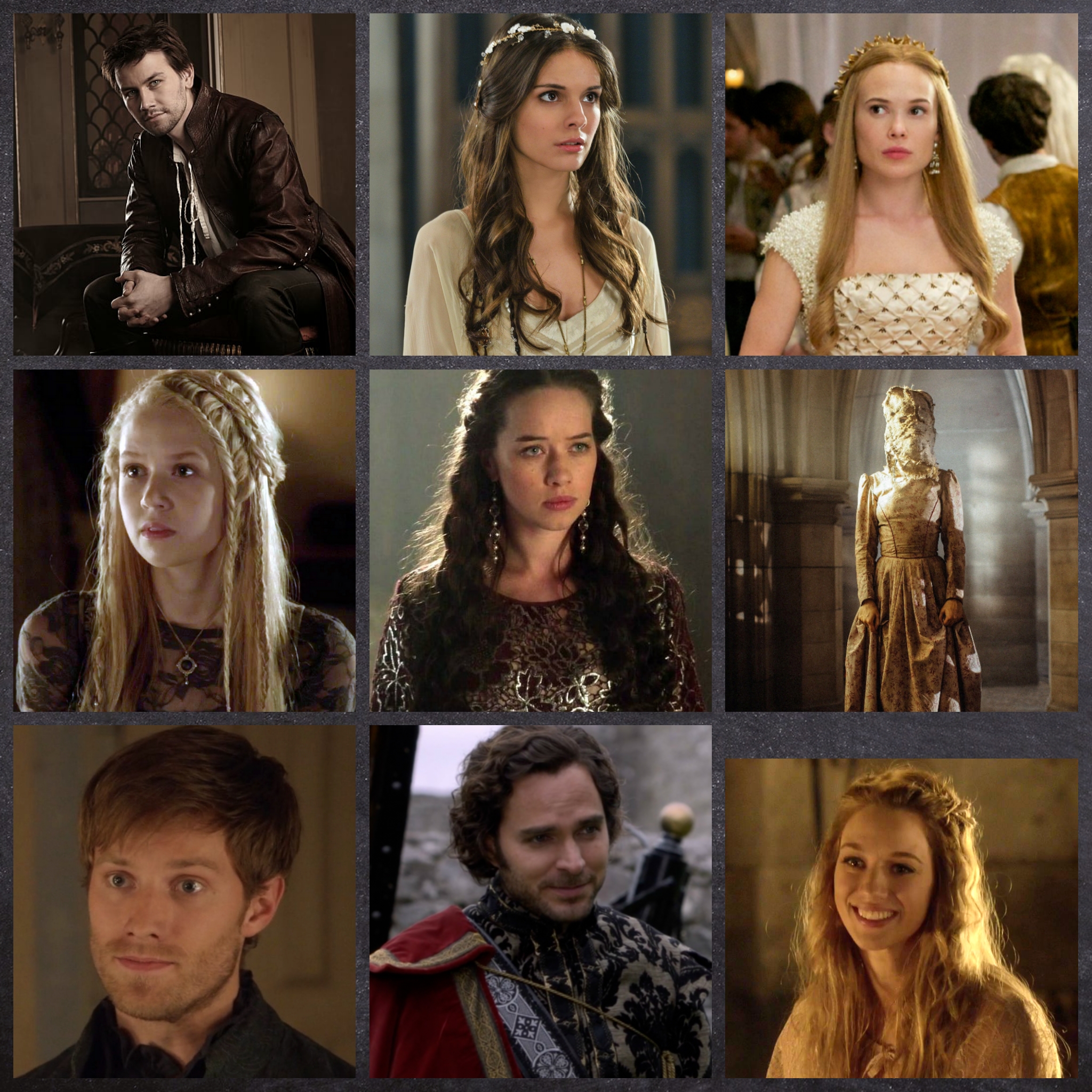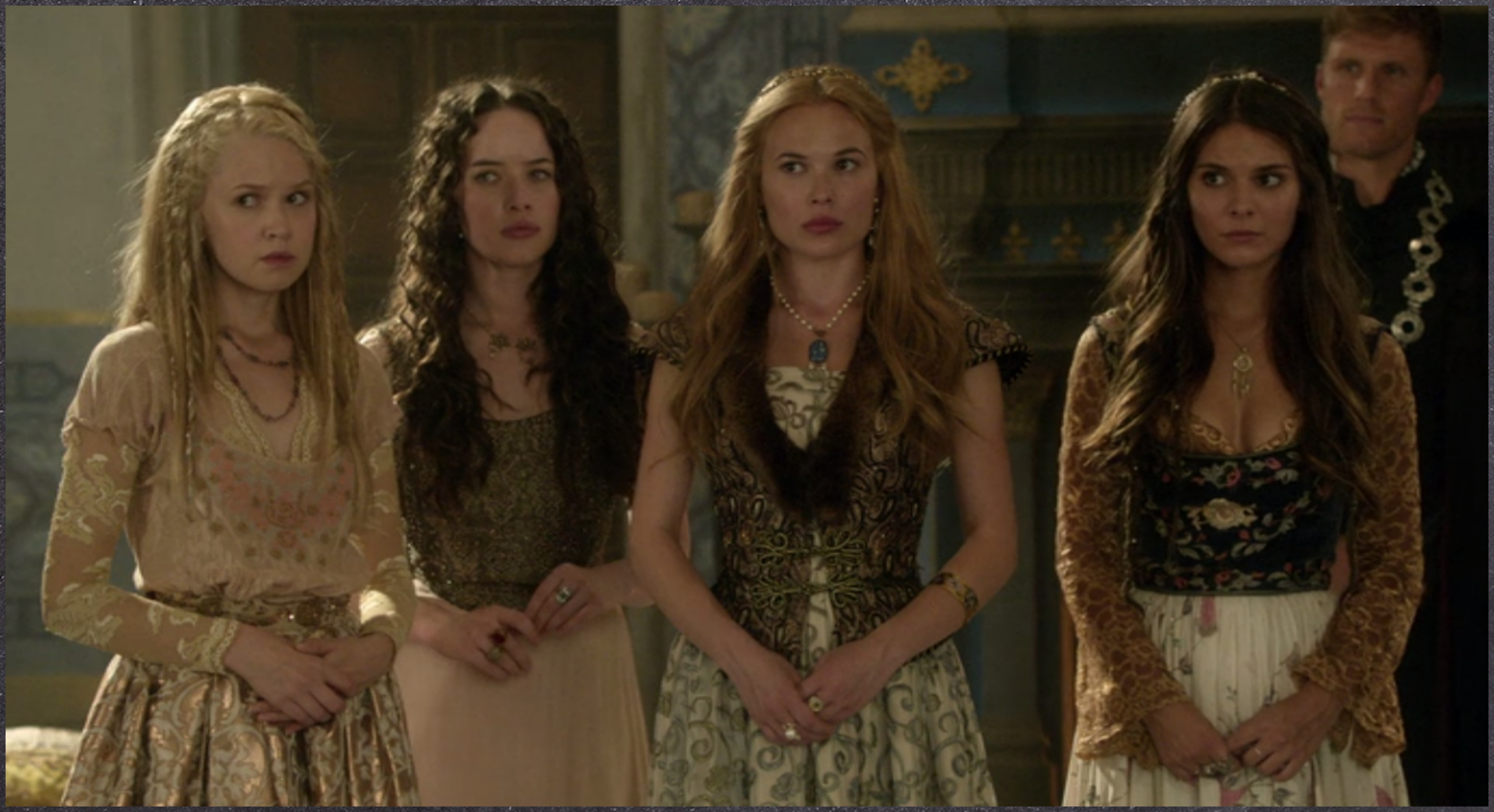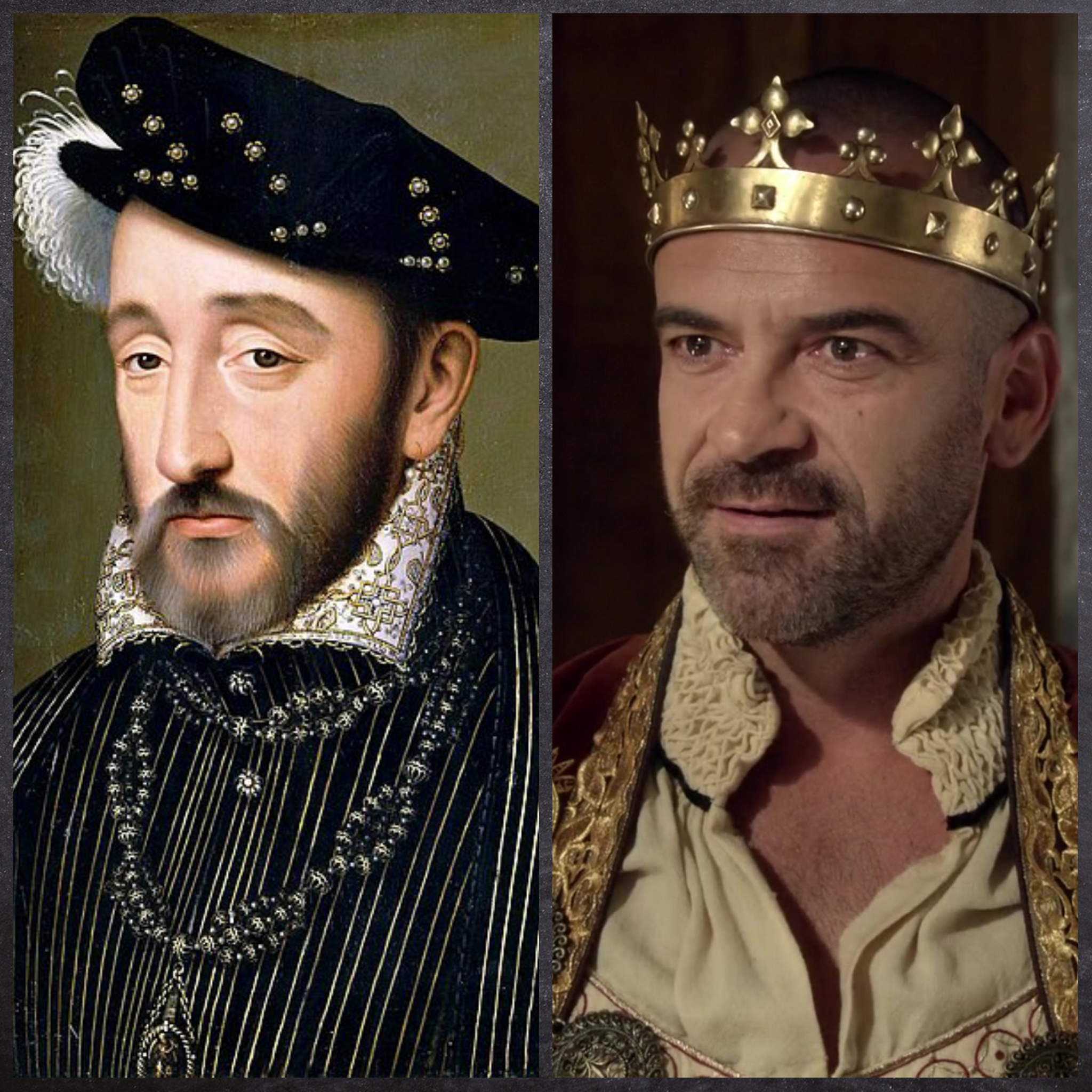At the risk of making myself immensely unpopular, I finally watched Reign and I enjoyed it. There, I said it. It bears no resemblance to history, the costumes are ridiculously anachronistic, more than half of the characters never actually existed, the storylines are insane, there isn’t a chaperone to be found, and yet, I love it. It’s so dramatic and fantastical that I don’t even mind the bad acting. In terms of historical accuracy though, there’s practically none. A great many of the storylines are completely fabricated involving fictional situations with fictional characters. This isn’t particularly new for this kind of drama but others of its kind tend to amalgamate characters into composites, and draw on several historical events to create an entirely new drama rather than invent situations completely.
If we were to ask the question ‘Is Reign’ a true story? We’d have to answer no. Aside from some minor events in backstory, Reign is a fantasy and its only claim to history is that there was indeed a Mary, Queen of Scots who married Francis, Dauphin of Viennois. I’ve written more extensively about Mary’s life here and her post-France years prove to be far more dramatic than her early years there. But that doesn’t stop Reign spinning one hell of a story…
Who, in Reign, actually existed?
We’re going to start with a rundown of the main characters and whether or not they were real people at the French court.
Mary, Queen of Scots: The show is based on the ‘reign’ (ah, we see what they did there) of Mary, Queen of Scots who was indeed an actual person. The show opens in 1557 when Mary is fifteen years old which is, and I’m not going to say this very often in this piece, believe me, historically accurate! In 1557, Mary was at the French court. She was fifteen years olf and betrothed to the Dauphin.
Francis, the Dauphin of France: Also a real person, Francis was the eldest son of Henry II although he’s aged up for the purposes of the drama in Reign. Historically, Francis was two years younger than Mary and thirteen in 1557.
Henry II and Catherine de Medici: King Henry and Queen Catherine of France were real people. As we will find out, they’re the most historically accurate characters in the show given that at least some of their personalities are drawn from actual events. It isn’t much but it’s all we’ve got.
Diane de Poitiers: The mistress of Henry II who wields enough power to be considered a threat to Queen Catherine, and another one who existed. Diane was almost twenty years older than Henry and a favourite of his mother’s ladies. Henry and Diane were lovers before he became king or married Catherine and remained so until his death.
Sebastian de Poitiers: Sebastian or ‘Bash’ as he’s known in the show is the illegitimate son of Henry and Diane. As the King’s bastard and Francis’ elder half-brother, Bash is a central character to the series. In history, though, he didn’t exist. Diane and the King didn’t have any children together. Henry had three illegitimate children by three different women. One daughter and two sons, both called Henri, however none of these served as the inspiration for Bash.
Kenna, Aylee, Greer, and Lola: Mary’s four ladies in waiting who arrived in France to attend her were not real people. Mary did have four ladies, all of whom were called Mary (collectively known as the four Marys) but their lives bear absolutely no relation to the four we see in the show.
Nostradamus: The French astronomer Nostradamus did exist and he made prophecies. He was a favourite of Queen Catherine, as he is in the show, though he was much older (he was in his fifties when Mary came to court).
Clarissa: Queen Catherine’s illegitimate daughter by the Vicomte Richard Delacroix. Born with an hereditary birthmark, Catherine gave the girl to Nostradamus’ father to remove the mark but the resulting surgeries left her grotesquely deformed. Rather than admit to his failings, Nostradamus’ father told her that the child had died but Nostradamus took her to court and kept her hidden. Needless to say, she didn’t exist, neither did her father, and Nostradamus’ father was a grain merchant who would have been over eighty years old at the time of Clarissa’s supposed birth.
There are of course a range of supporting characters to fulfil the role as courtiers and visiting nobles. Of those that didn’t exist we have:
- Colin (Lola’s fiance who was recruited by Queen Catherine to rape Mary – this did not happen)
- Leith Baynard
- Simon Westbrook
- Tomas of Portugal (John III of Portugal did not have an illegitimate son he attempted to legitimize and he wouldn’t have been engaged to the actual Queen of Scotland even if he had existed).
- Olivia D’Amencourt (The character also couldn’t have represented Francis’ previous lovers before Mary as he was far too young to have them).
- Lord Castleroy
- Lord Hugo
- Lord Julien Varga
- Penelope (While the person of Penelope didn’t exist, the Queen of the Bean was an actual festival celebrated as part of Epiphany, though its selection was limited to prominent ladies of the court rather than servants).
- Christian de Guise (Marie de Guise did have brothers but none called Christian and none who the character might have been based off).
- Lord McKenzie (Catherine de Medici did not order the massacre of several Scots to protect a clause in a marriage treaty. There was a secret clause in the treaty in question, but it had been agreed by Mary)
- Hortenza de Medici
- Roman de Medici
- Francesca de Medici
- Pietro de Medici (There was a Pietro de Medici in history but at the time the show is set he would have been two years old)
- Sisila, Archduchess of Bohemia (I’m afraid Sisila is fictional, as is her story of falling to her death from a window while having sex with the King of France forcing Henry and Catherine to stage her suicide. I know, I’m devastated too).
- Ferdinand, Archduke of Bohemia (In theory there was a man who could have been Ferdinand of Bohemia, but Bohemia was ruled by Kings not Archdukes, and this Ferdinand was the Holy Roman Emperor, which is a little grander than the provincial gentleman presented in Reign).
- Isabel Derant (Her relationship is obscure in the show but as Bash is fictional, we can assume so is Isabel; his half-cousin once removed)
- Pascal
- The Darkness (More on this soon).
There were however, some that did exist, though the list is considerably shorter:
- Marie de Guise (Mary, Queen of Scots’ mother and regent of Scotland in her daughter’s absence)
- James Stuart, Earl of Moray (One of James V’s very many illegitimate children, James Stuart was a potential rival to his half-sister Mary despite his illegitimacy, and was a prominent Scottish lord).
Mary, Queen of Scots and Francis
The Show: The opening of season one focuses on Mary and her betrothal to the Dauphin, Francis. The betrothal is not set in stone and won’t be until they’re married, leaving Mary a pawn of the French king until he determines whether or not she’s worth an alliance. Mary is sent to the French court at nine years old but, fearing for her safety, Catherine de Medici has her moved to a convent. When she emerges, she expects to marry Francis immediately but both Francis and King Henry delay the wedding because an alliance with Scotland isn’t actually in France’s best interests anymore.
Mary and Francis slowly fall in love, though the issue is complicated by her developing feelings for his brother, Bash, and the fact that people keep trying to kill her or rape her. As if that weren’t bad enough, the court seer Nostradamus has had a vision of Francis’ death if he marries Mary. These issues combine to see Mary betrothed at various points to Francis, Tomas of Portugal, and Bash who must be legitimized in order to make himself worthy of a queen’s hand. His father intends to annul his marriage to Catherine, marry Diane, and make Bash the Dauphin at the expense of his legitimate bloodline, in return for Mary’s claim to the throne of France.
Eventually, true love conquers all and Nostradamus realizes his vision was mistaken and Mary can be happy with Francis. (He then realizes that this second vision was mistaken but he keeps that to himself given how he’s already destabilized the kingdom for it). Mary and Francis are married after Marie de Guise arranges for false news to be delivered that Mary I is dead and Mary, Queen of Scots is now potentially Queen of England too. The two retire to their bedchamber where they consummate the marriage in front of the court.
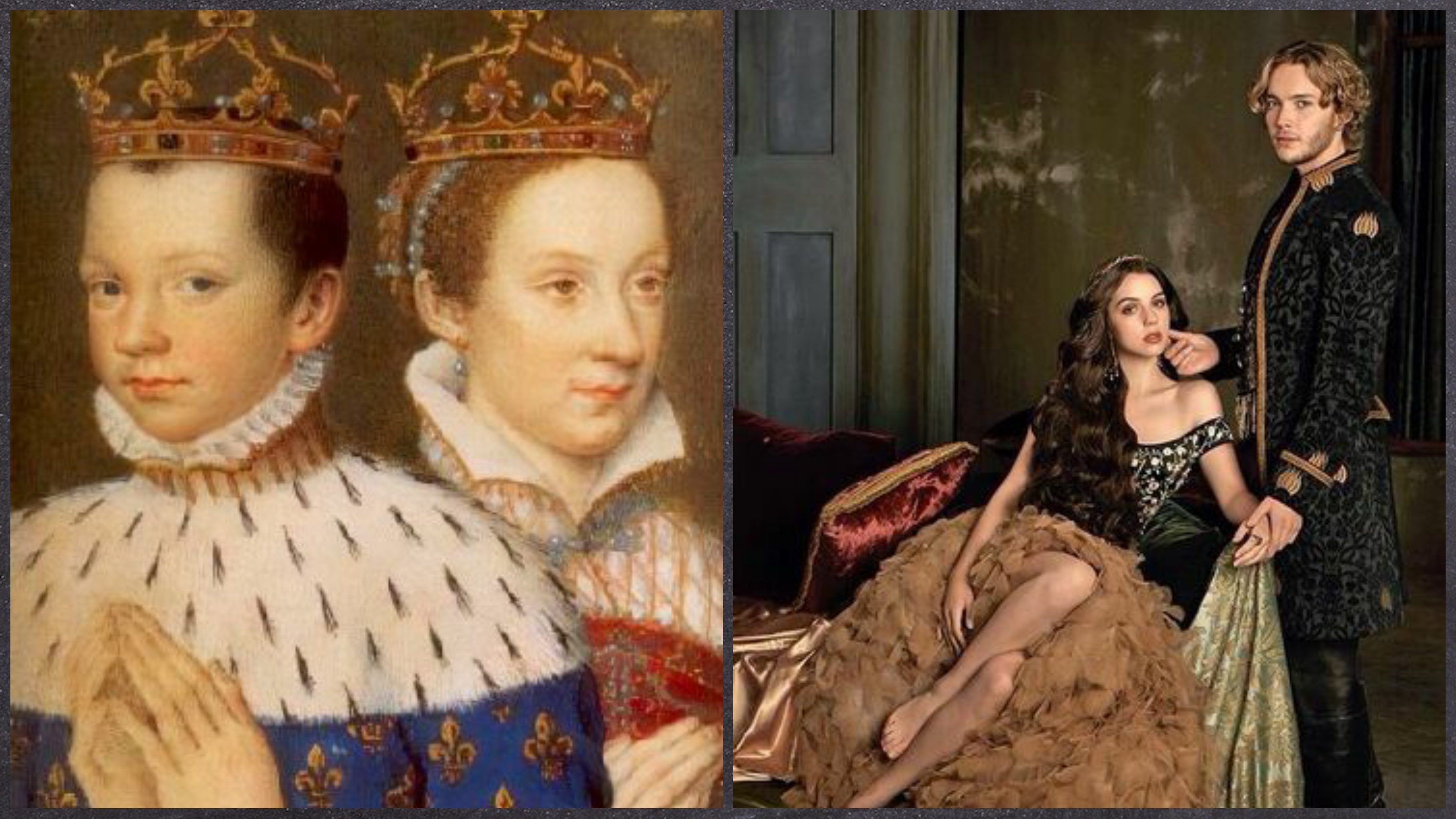
In History: Not much of this actually happened but it doesn’t half make for fantastical drama.
Much is centred on the English attempting to kill off Mary so that they can take the crown of Scotland for themselves. Mary’s position was an interesting one and her relationship with England would be a complicated one for the entirety of her life. She inherited the throne of Scotland at only six days old, at which time Henry VIII was King of England. Henry wanted her to marry his three year old son Edward which would have united the kingdoms of Scotland and England. In theory, an excellent alliance, but the Scots and Mary’s mother, Marie de Guise were not so disposed. They rejected the repeated proposals which resulted in several years of war sometimes called the ‘Rough Wooing’. Henry decided if he couldn’t win Mary by diplomacy, he would beat Scotland into submission and force them to capitulate.
To the shock of literally no one, this didn’t actually endear England to the Scots. When Marie brokered a marriage treaty between her daughter and the Dauphin of her native France. It was greeted enthusiastically by everyone except the English but really, who cared about them?. France and Scotland were, after all, old friends against England. Their relationship was called ‘the auld alliance’ and born from little more than mutual dislike of the English insistence of sovereignty over their territories. Can’t relate.
Mary left for France when she was five years old and would remain there until her marriage to Francis in 1558. She wasn’t sent to a convent for her own protection but it is one of the few instances of the show rooted in actual history. The children of nobles and sometimes royalty might attend monastic establishments for their education. As it happened, Mary was educated privately by her tutors but her four ladies were sent to a nearby convent where they received an education appropriate to their position. Mary however, didn’t live in a convent and the English weren’t trying to kill her.
In fact, the English would have put themselves in a rather sticky position if they’d tried or actually killed Mary, as opposed to just leaving her alone. Mary had more of a claim to the throne of England than any of the Tudors had to that of Scotland. She was the granddaughter of Henry VIII’s sister, Margaret, though Henry had barred her from inheriting the English throne. He barred Mary and Elizabeth too so that wasn’t saying much. If they had killed her, then aside from the international scandal they’d have invited by assassinating a Catholic queen on foreign soil, the Scottish lords were far more likely to turn the throne over to one of their own, or more likely, Mary’s half brother James Stuart, rather than invite Henry VIII to reign.
Incidentally, when the English aren’t trying to kill her, the Queen of France is recruiting one of her lady’s fiances to drug and rape Mary under the notion that if she isn’t a virgin, Mary could never marry the Dauphin. It feels a little understated to say that this didn’t happen. The Queen of France did not recruit a man to rape Mary, Queen of Scots so as to nullify a marriage treaty between France and Scotland. I just wanted to type those words out. I feel we should consider though that even if Colin had succeeded and deflowered Mary, it wouldn’t have actually affected anything politically. Rape was very much a crime and the rape of a monarch was unconscionable. To put your hands on the body of someone consecrated by God was one of the worst crimes imaginable at the time. For Colin, it would mean an immediate and brutal death sentence. For Mary, aside from the trauma, it wouldn’t have actually changed anything. Virginity may have been a moral requirement for a royal wife but a loss of it was a scandal rather than a legal impediment.
The agreement between Mary and Francis was also not as flimsy as the show suggests. They go to great lengths to stress that a betrothal is not a marriage, except historically, it practically was. Breaking a betrothal was no easy matter and involved as much legal paperwork and hoop-jumping as dissolving a marriage. During her time in France, Mary was engaged to and only to, Francis, and not just because her other suitors, Tomas of Portugal and Bash, didn’t exist. Had the opportunity arisen, she couldn’t have married either of them anyway.
The storyline of Bash is especially incredible. Mary decides that in order to keep the peace between Scotland and France and save Francis’ life into the bargain – she’s going to marry the next king of France as agreed. Except that king of France will be Bash [dramatic music]. She demands that King Henry go to the Vatican, legitimize Bash, and displace the line of succession in return for Mary’s tenuous claim to the throne of England. Marvellously, Henry agrees and begins the process.
Now, the issue of dissolving an existing betrothal aside, the idea of a fourteen year old Mary demanding that the King of France uproot his entire dynasty for the sake of a bastard child and a prophecy is so incredibly ridiculous it’s fantastic to watch. So needless to say, it didn’t happen, but even the thought of it is absurd. By Catherine, Henry had seven surviving children. In the show, one of them, Elisabeth has already married the King of Spain. If Henry had annulled his marriage to Catherine then it would have had incredible repercussions in Spain as well as France.
Spain was much bigger than England, had a considerably more powerful army, and shared a border with France. They wouldn’t have been all that inclined to mug off their much more powerful and threatening neighbour by making their Queen illegitimate. Beyond that, it’s a simple numbers game. No king would throw off seven legitimate royal children for the sake of one illegitimate son, especially when four of those seven were healthy boys who survived infancy.
As for whether Francis and Mary were in love. They apparently got on very well but they did not have a relationship the way they do in the show. Francis is aged up for the show and was in reality a young boy of thirteen. They wouldn’t have been able to kiss or sleep together the way that they do in the show. Something that’s going to come up quite a bit is the sheer amount of sex could not have happened. Mary would have had a host of chaperones to ensure she remained chaste, and her ladies would have had the same.
Public consummation also wasn’t something that occurred at this stage, even among the royals. The act of putting the royal couple to bed was a ceremonial act and involved much procession among the nobility and guests, but the actual sex that followed it wasn’t witnessed by anyone. If it was then the King’s Great Matter across the Channel would have been quite easily put to rest. We do know, however, that Henry II’s father, Francis, watched his son and Catherine de Medici consummate their marriage but the fact that this is noted in the history books show how outlandish it was.
Kenna, Greer, Lola, and Aylee
The Show: Mary has four ladies in waiting to act as her attendants and friends. All from Scotland, they were her companions in childhood and are reunited with her in France when she rejoins the court. They form a close knit group, becoming the best of friends while engaging in their own intrigues at court.
We have Lady Kenna who comes from a noble family with money and lands. Kenna witnesses the bedding between Princess Elisabeth and King Phillip and runs off to find a quiet place where she can masturbate. Her session is interrupted by the king who joins her and eventually takes her as his official mistress, displacing Diane de Poitiers. Their relationship ends when a mad Henry forces her to marry his son Bash.
Lady Greer has no wealth or title and has to make a good match in order to secure the dowries of her sisters. Initially, she embarks on a love affair with a kitchen servant Leith, but she breaks it off in favour of a better marriage with Lord Aloysius Castleroy who she develops affection for.
Lady Aylee comes from a family that apparently owns half of Scotland, had a brief stint as a kleptomaniac, stealing from her mistress, and dies in the first half of the season to fulfil one of Nostradamus’ prophecies.
Finally, there’s Lady Lola who comes from a magnificently wealthy family. Her first love interest is Colin who is executed after he attempts to rape Mary. Then she has a one night stand with Francis which sees her falling pregnant with his child. She marries Lord Julien Varga of Hungary to legitimise the child only to discover Julien is a fraud and has to abandon her after she helps him fake his own death. The drama never ceases.
In History: I’m going to start with the most utterly inconsequential issue I have with these four ladies. Aylee might be how the name is said but in Gaelic is written Eilidh. It’s a minor quibble given that the names in general are hugely anachronistic but it annoys me that they actually used a Scot name and then went and anglicised the spelling for the sake of the credits. As another minor aside, service in the queen’s retinue did not automatically grant you the title of ‘Lady’. As unmarried ladies in waiting they would have been addressed as ‘Mistress —”
Anyway, linguistics aside, the four ladies are based on the four Marys; Mary Seton, Mary Livingstone, Mary Beaton, and Mary Fleming. They were four girls of Mary’s age from Scottish noble families who accompanied the five year queen to France. When they arrived, they were separated so that Mary could be educated by French ladies and the girls were educated at a French convent. They later rejoined the queen’s retinue and went on to live perfectly appropriate lives with none of the scandal or colour of their fictional counterparts. There was no displacement of Diane de Poitiers, royal bastard, premature death, or scandalous love affair. There were just four women who wouldn’t have been able to have any of those adventures because of… wait for it… chaperones.
Nostradamus
The Show: The rugged and enigmatic Nostradamus lives at court at the request of Queen Catherine who relies on the visions he has of the future and prophecies he makes from them. While there, he acts as the court physician and runs the infirmary. His vision that the marriage between Mary and Francis will result in the latter’s death forces Catherine and Mary to take drastic action to protect the Dauphin. When he believes himself to be mistaken, the marriage goes ahead and he doesn’t tell anyone that actually, the vision came back and Francis will die after all. He has a brief liaison with Francis’ former lover, Olivia, but sends her to live a life without him when it becomes clear Catherine won’t allow him to leave with her.
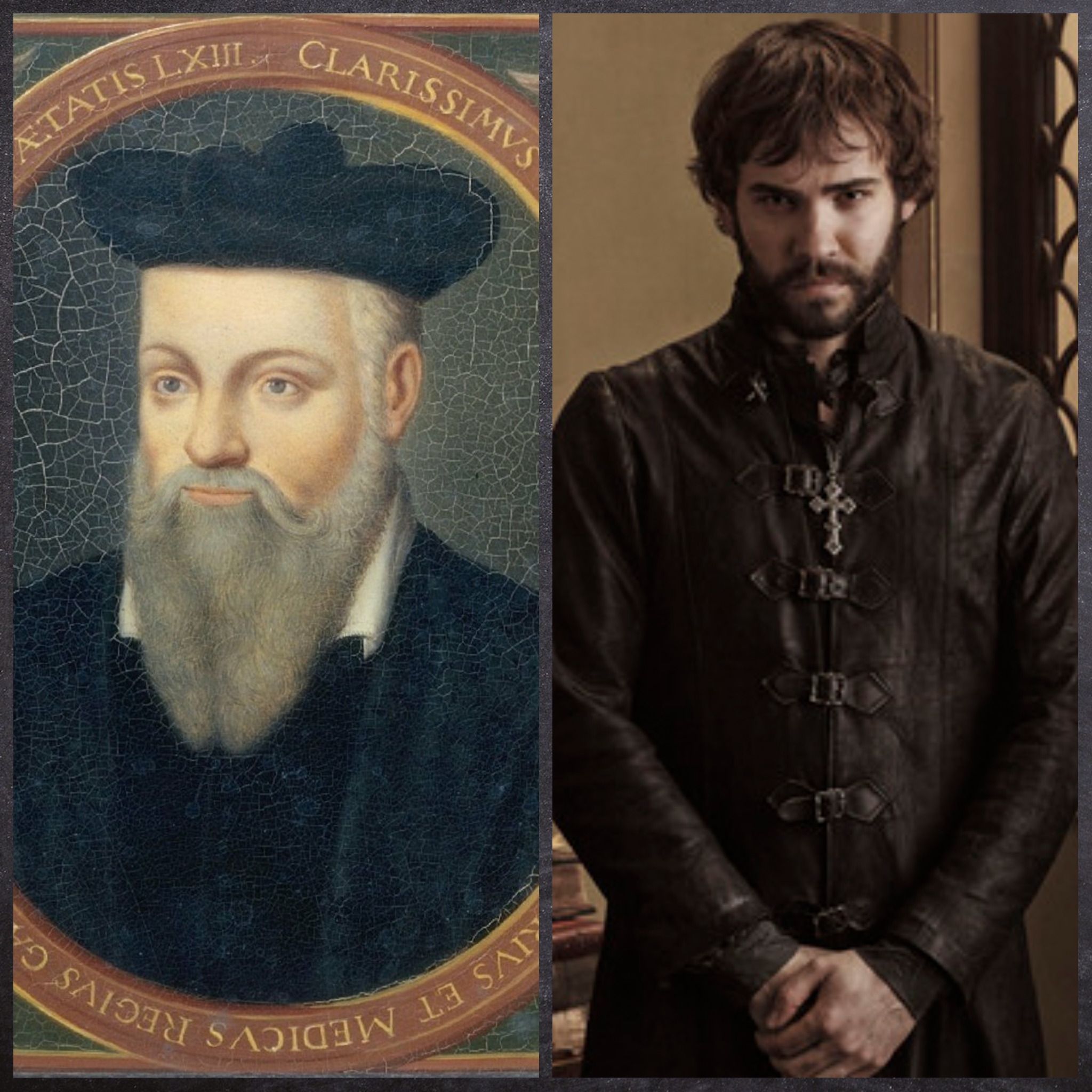
In History: Nostradamus did spend time at court at the request of Queen Catherine who’d heard of his prophecies. The work of astrologer and apothecary overlapped surprisingly and so Nostradamus was appointed as the physician of the young Prince Charles. He had specifically been invited to cast horoscopes for Catherine and her children but was reluctant to do so given that it was treasonable to predict the future or cast horoscopes of the royal family. The queen gave her assurance that he would not be tried for it and continued to patronise him for many years.
You’d think that predicting the future would be enough to have Nostradamus burned at the stake for heresy but prophecy was a gift recognised by the church. As long as he didn’t attempt to assist the process by utilising magic, the church would leave him alone. He didn’t, so they did. Mostly. While we don’t know the specifics of Nostradamus’ horoscopes, he allegedly told the queen that all of her sons would become king but that she would outlive them all. For the most part this was true. Three of her four sons became King of France and she did outlive all but one of them; Henry III who was assassinated seven months after his mother’s death.
Had he foreseen that Francis’ death was the result of his marriage to Mary, it’s extremely unlikely that the marriage would have been stopped, even if the queen had supported it. Marriage treaties were drawn up between countries and were not easily dissolved, especially on as flimsy a pretext as the visions of a man perilously close to treason.
The Pagans, the Darkness, and the Blood Wood
The Show: On the very doorstep of the French court is a dark forest inhabited by bloodthirsty pagans who engage in bloody rituals. They make human sacrifices to the ‘darkness’, a mysterious beast who apparently feeds off the blood of the victims to hold off an impending apocalypse. Diane de Poitiers was born into the religion, as was Bash, but she became Catholic when she began a relationship with the king.
Anyone found to be practicing paganism is burned as a heretic as Bash would be if anyone found out about his religious upbringing. The pagans mark several members of court for death at various points including Mary, which they do by leaving a severed stag’s head in her bed beside her. The following morning she lets Johnny Fontane out of his contract, bowing to the pressure from the Corleone family. No wait, wrong movie.
In History: Nothing even remotely like this happened.From the 1500s, paganism was a rather loose term applied to anything that wasn’t Christian or Judaic. As such, there wasn’t a notion of paganism as we might understand it though there are some common themes in modern paganism and medieval folk religions. Namely; the reverence of nature and polytheism rather than ritual blood sacrifice.
There was no cabal of pagans gathered near the French court and if there had been then the entire forest would have been burned to drive them out and anyone suspected of participating or aiding would have been executed. Diane de Poitiers was a Catholic and if Bash had existed, he would have been too. They wouldn’t have been able to move around the castle freely and couldn’t have left a stag’s head in the Queen of Scotland’s bed. Partly because [drum roll] chaperones. Also armed guards.
Catherine de Medici
The Show: Queen Catherine wields immense power at court though much of it in opposition to her husband. She wasn’t royal herself, rather a member of the Italian nobility but managed to marry Henry because of her vast fortune. The Medici family is still hugely wealthy but operates in secrecy and shadows. They manipulate governments, assassinate their enemies, and generally exercise vast amounts of power despite their lack of royalty.
Catherine is also the centre of an intelligence network of her own creation. She has a group of specially trained ladies known as ‘The Flying Squad’ who sleep with prominent nobles and report their movements and plots back to Catherine which she uses to cement her power. During the show, she recruits her rival, the kitchen girl Penelope, to become one of the Flying Squad, sending her to Florence where she will learn the art of espionage and subtlety before returning to act as a spy for Catherine.
During her adolescence, Catherine was held hostage in a convent for several years by the people of Florence who rebelled against the Medicis. While there she was allowed little comfort and it’s later revealed that she was raped by her captors. After her release, she is married to Henry II who at that point was second in line to the throne.
Her inability to conceive drove her to seeking all kinds of medical and spiritual interventions but proved ultimately successful. During this time, she fell pregnant by her lover but believed her first child to have died shortly after the birth. Her interest in the occult has her bring Nostradamus to court as her advisor, utilising his gifts of prophecy to preserve her power and protect her children.
When Mary demands Henry II legitimize Bash, Catherine is arrested and held in the dungeon to prepare for her execution. When Mary decides to marry Francis after all, Catherine is released and restored. She plans a coup with Francis and Mary to kill her husband when it seems his madness has become untenable. The coup doesn’t happen but Henry dies anyway leaving his wife as Queen Catherine, the Queen Mother.
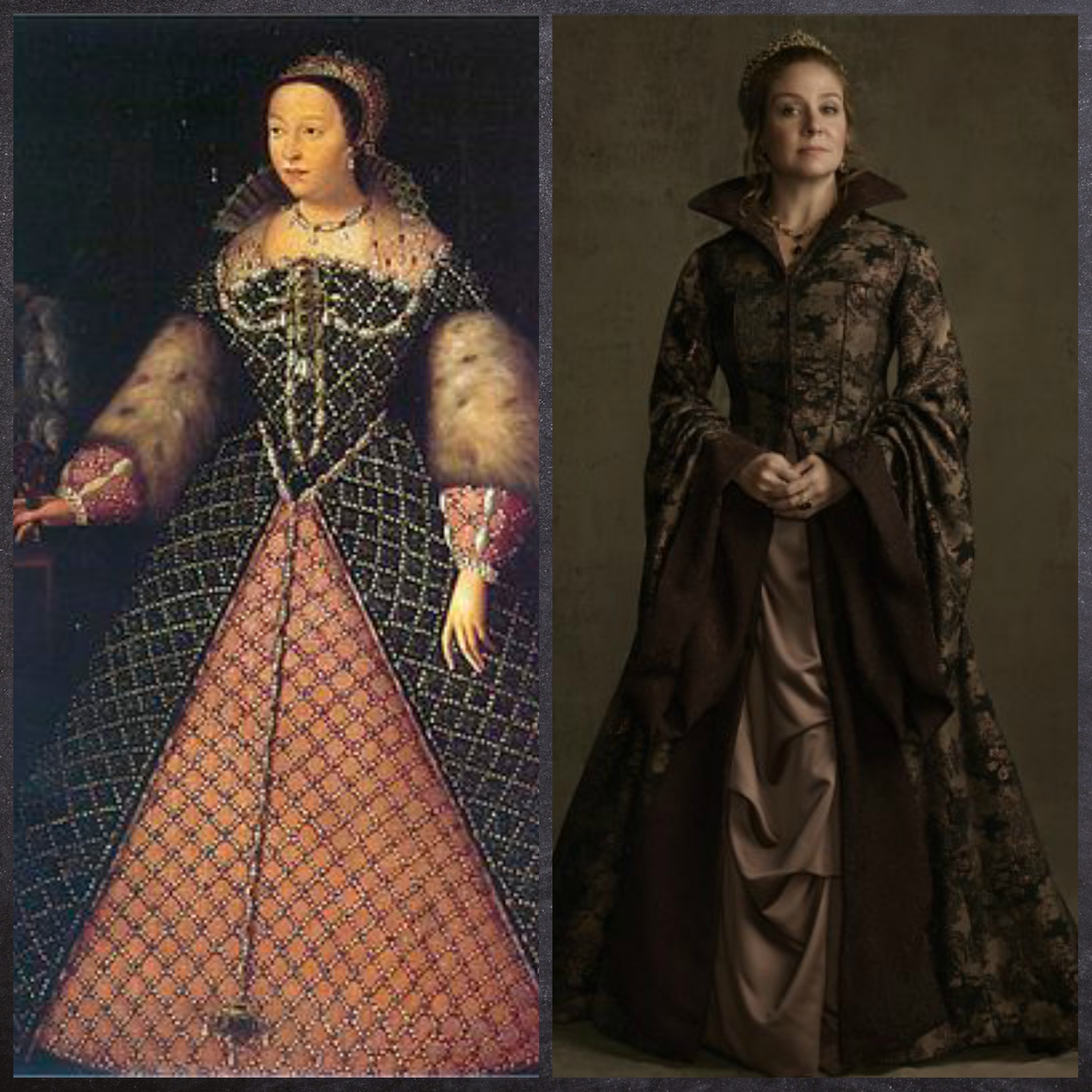
In History: Catherine de Medici has a reputation that fits her portrayal in Reign. She’s gone down in history as being scheming, manipulative, determined to protect her own power, a reputation which seems to come from a single event in history rather than the way she lived the majority of her life. Nevertheless, the scheming Catherine we see does have some basis in history and her backstory draws heavily from actual events.
As a child she was captured by rebels intent on overthrowing the Medici family and spent many years being moved between convents. So Reign actually got that right! Apparently, her time at the convent from which she was ultimately rescued was among the happiest of her life. But during the Siege of Florence, there were calls from the citizens and her guards to be executed but not before she was passed around naked for their pleasure. There’s no record that she actually was but the situation lasted for eleven months. We have no way to know if the guards raped her or not. It’s likely they didn’t make good on their threats, and before the siege Catherine had enjoyed an affectionate relationship with the people of Florence. Even though she wasn’t royal, she was a noble of the highest ilk and would have had guards and protection. If something had happened to her, she likely wouldn’t have mentioned it. I wrote earlier that rape was a crime, and it was but the implications of raping the Queen of Scotland vs an Italian noblewoman are quite different.
While we might not know how far the threats went, we can appreciate how terrifying a situation Catherine was in. At the time she was eleven years old and from within the convent, however happy her experience had been to that point, she would have heard the threats against her during the eleven month siege.
Three years later she was married to the second son of the French king but for the early years of their marriage Henry was more interested in his mistresses than attending his wife. Despite this, Catherine was popular at court, and Henry’s mistress, Diane, ultimately convinced him to spend more time with her. The pressure to produce an heir only increased when Henry became the Dauphin during which time Catherine’s dowry fell through. This left her a rather unattractive prospect as a wife and talk of divorce was entertained. It was around this time, as the show suggests (I know, I’m surprised too) that she began consulting physicians and utilising all kinds of remedies in order to fall pregnant. Ultimately, it was not one of the bizarre concoctions or folk rituals she engaged with that led to conception but rather a visit by a physician who observed abnormalities in the couple’s sexual organs. His advice clearly worked as Catherine soon fell pregnant and went on to have eight children by her husband. There is no evidence that she committed adultery or had an illegitimate child.
The storyline that saw her committed to the dungeon for treason while her marriage was potentially annulled was fictional and her imprisonment wasn’t drawn from any historical events. She was never imprisoned or arrested by her husband who, despite his preference for the company of his mistresses, never impugned Catherie’s position as Queen consort.
The idea of a Flying Squad is exaggerated for dramatic purposes. The notion of Queens utilising ladies to gather information around court is hardly a new one but Catherine maintained a group of eight ladies to engage in liaisons with relevant nobles and pass on information. It’s a stretch to suggest that they would have been formally trained as spies in Italy. Instead, they would have been women already at court recruited for Catherine’s purposes. Rather than maintaining a vast network of “spies” Catherine, like most Queens, cultivated good relationships with useful ladies and rewarded them if they gave her information she could use.
Henry II
The Show: Henry is a strong and established king with little threat to his power while he increases the security of his kingdom by making strong marriage treaties. After Francis is married to Mary, Henry becomes increasingly affected by mania and insanity. His sexual escapades become dangerous for the women involved with them. The Archduchess of Bohemia falls from a window when Henry tries to have sex with her on the ledge. He invites a woman into a threesome with himself and Kenna, only to strangle her while Kenna sleeps. He propositions his daughter in law, Mary, to another threesome, and embarks on a dominant/submissive BDSM relationship with the kitchen girl, Penelope. (He’s the submissive).
In his desire to take England for France, he has his armies attack Calais against the advice of his generals who he promptly dismisses. It is only through Francis’ direct intervention that the assault is a success and Calais returned to French rule. Henry’s madness only increases and he plots to kill his son and take Mary as his wife, as the ghost of his dead brother haunts him and gives him advice on how to reign. During this time, he reveals to Francis that as a child he’d been exchanged for his father’s freedom and was tortured for years as a Spanish prisoner. He also admits to poisoning his elder brother after a tennis match so that he could become king.
Ultimately, his insanity becomes unmanageable. He starts killing courtiers indiscriminately, arranges a mock naval battle with live powder which kills over a hundred of his soldiers, but it all comes to a head when he rides in a joust and his opponent, Count Montgomery strikes his lance through Henry’s helmet, leaving a splinter through his eye. As the crowd gather to help their king, Count Montgomery slips away to be revealed as Francis! Gasp! His sense returns to him in his last few hours and he begs Catherine to look after Diane and be her friend before he passes.
In History: As with Catherine, Henry’s backstory for the show is based on actual events. Henry was the second son of King Francis I and heir to the throne after his elder brother, also called Francis. In 1525, Francis was captured by the kingdom of Spain after his crushing defeat at the Battle of Pavia. Although he committed to a treaty with Spain, his reputation was such that he wasn’t expected to actually adhere to it. To secure his return to France, he arranged for his two eldest sons to be brought to Spain in his stead. Seven year old Francis and six year old Henry were brought to Madrid where they were imprisoned in various prisons and dungeons, all of which were better suited to common criminals than royal prisoners of exchange. They remained there for almost five years before they were finally returned to France. During these years, King Francis had indeed broken numerous conditions of the treaty.
The elder Francis’ health never fully recovered from his time in prison and aged eighteen, shortly after a tennis match, he died of tuberculosis. Given his age and the suddenness of his death, it was widely speculated that he’d been poisoned. The man who had given him his drink after the match confessed to it under torture but recanted before his execution. It was rumoured that Henry and Catherine had instigated it given that they had the most to gain but there was no evidence of foul play.
Beyond this however, his story doesn’t resemble much of Henry II’s life. For a start, he didn’t go mad and was quite sane at the time of his death. He had a number of mistresses and while we can’t speculate on what exactly went on behind closed doors, his proclivities would have remained quite firmly behind said closed doors. He didn’t pursue Mary as his wife and it’s very unlikely he would have invited her to a threesome. According to canon law, by marrying his son, Mary became Henry’s daughter and any kind of marriage or sexual encounter with her would have been incest for the Catholic rulers. Theoretically, he could have married her with papal annulments but he didn’t attempt it and his power didn’t run far enough that he could have secured it if he tried. Nor could the king just randomly start killing his guards or courtiers without cause. Or rather, he could, if he wanted a bloody coup on his hand and as Henry had complete control of his senses then we can assume he’d want to avoid such a thing.
Towards the end of his reign, the assault on Calais wasn’t an ill-advised product of madness. On the contrary, it was one of Henry’s greatest if not unexpected victories. France had been at war with Spain over their mutual claims to Italy for seven years when England, at the command of Queen Mary, decided to throw their military weight behind her husband, the King of Spain. It did not go well. With a legitimate reason to attack, the Duke of Guise secretly raised an army of thirty thousand men and took Calais. Strategically, Calais wasn’t exactly of paramount importance to France, but in terms of morale it’s significance can’t be overstated. The loss of Calais was a blow to England and meant that subsequent monarchs of England could no longer style themselves King/Queen of France which they had been doing for centuries thanks to their ownership of Calais. As an aside, Henry’s son Francis did not fight in the battle.
The year after Calais had been retaken by the French, the Italian War was concluded with a peace treaty and the marriage of Henry’s daughter Elisabeth to the king of Spain (whose wife Mary had recently died). In the show Elisabeth and Philip are married in the opening episode, but this event didn’t occur for another two years in reality. As part of the celebrations, a joust was arranged (sans mock naval battle with real ammunition) which Henry was to participate in. Henry, wearing the colours of Diane de Poitiers as ever, rode against Gabriel de Lorges, Count of Montgomery and Captain of the Scots Guard. Henry had apparently been suffering headaches recently and found himself dizzy at heights, but despite the appeals of those around him, he insisted on riding. The first pass almost saw him unseated and once again an attempt was made to convince him to leave the lists. Montgomery also attempted to refuse the contest but the king won out and they rode again. This time Montgomery’s lance struck the king’s helmet sending three splinters into his head, including one which pierced his eye and brain.
Somehow, Henry maintained consciousness enough to pardon Montgomery. He also survived the procedures to remove the splinters and it was hoped that the worst he would have suffered was the loss of one eye. Over the next nine days however, the wound became infected and on the 10th July 1559, Henry died. In his final days he had called out for his mistress, Diane, but Queen Catherine refused to have her admitted. Immediately following his death, Catherine had Diane removed from court and evicted from certain properties that Catherine had long wanted. Diane spent the rest of her life living in obscurity, albeit comfortable obscurity in one of her remaining châteaus.
If you’d like to join me for more fun and games in picking apart history, and other behind the scene tangents, you can support me via my Patreon.


